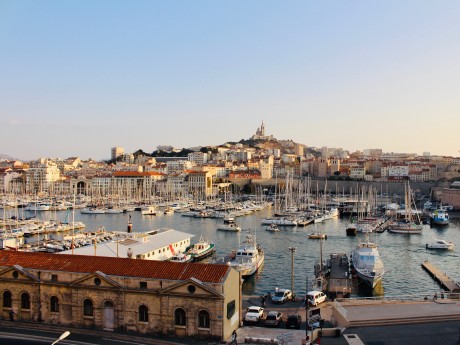France: Paris, Avignon, Marseilles & Cassis
This trip starts in France's Capital and goes to the heart of France, where a tapestry of alluring urban charm, revered wine country, and sun-drenched coastal beauty awaits. This realm of artistic brilliance and culinary mastery unveils iconic landmarks like Paris' Eiffel Tower, Marseilles' vibrant Vieux Port, Cassis' stunning Calanques and Avignon's historic Pont Saint-Bénézet and Palais de Papes.
Read more
This trip starts in France's Capital and goes to the heart of France, where a tapestry of alluring urban charm, revered wine country, and sun-drenched coastal beauty awaits. This realm of artistic brilliance and culinary mastery unveils iconic landmarks like Paris' Eiffel Tower, Marseilles' vibrant Vieux Port, Cassis' stunning Calanques and Avignon's historic Pont Saint-Bénézet and Palais de Papes. Roam the enchanting streets of Paris, immerse yourself in the lively spirit of Marseilles' bustling markets, bask in the tranquil allure of Cassis' crystalline shores and savour the rich flavours of Avignon's local vineyards. Indulge in French fashion and cuisine on Champs de Élysées, and savour a romantic dinner along the Seine river. Cassis offers breathtaking views in Calanques National Park and relaxing beaches. A rental car would be great for exploring Avignon, Marseilles & Cassis. Waterviews strives to offer accommodation options within walking distance of water and/or in an area of touristic interest. Our prices include taxes (but excludes local tourist taxes). Customize your trip to your personal preferences with optional activities (hit the “Add Activities’’) or change hotels, etc. Contact us for customization at no extra cost at: Service@waterviewstravel.com
Destinations
- Paris
- Marseille
- Cassis
- Avignon
Itinerary
Paris
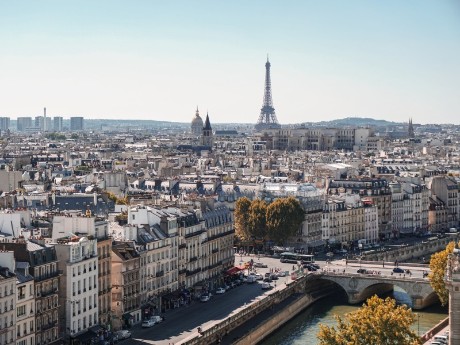
Renowned all over the world as a hub for art, fashion and culture, Paris is an enchanting city that is sure to make you fall in love. Its romantic atmosphere and beautiful setting on the banks of the River Seine are instantly charming, and the rich history, countless iconic landmarks and incredible culinary scene are like no other. Stroll through elegant boulevards, marvel at the Eiffel Tower, spend afternoons meandering in the Louvre and discover charming neighbourhoods - you won't be disappointed with the City of Light.
Read more
Renowned all over the world as a hub for art, fashion and culture, Paris is an enchanting city that is sure to make you fall in love. Its romantic atmosphere and beautiful setting on the banks of the River Seine are instantly charming, and the rich history, countless iconic landmarks and incredible culinary scene are like no other. Stroll through elegant boulevards, marvel at the Eiffel Tower, spend afternoons meandering in the Louvre and discover charming neighbourhoods - you won't be disappointed with the City of Light.
Additional Information
Due to high expectations, a tight schedule, and large crowds and long lines at certain attractions during high season, the city might disappoint some visitors. Foreign visitors who have an idealized view of Paris might be shocked by the typical challenges of visiting any large city; crime, traffic noise, pollution, garbage, and relatively high costs. In the worst case, visitors might experience the Paris syndrome; a psychological state of delusion.
To enjoy the wonders of Paris, make realistic plans. The amounts of attractions and landmarks is overwhelming; visiting only the most famous ones takes more than a week. The city also has more to offer for people who take time for a calm stroll along the backstreets. If your time in the city is short, be selective, and save some attractions for your next visit.
History
Paris started life as the Celto-Roman settlement of Lutetia on the Île de la Cité, the island in the Seine now occupied by the Cathédrale de Notre Dame. It takes its present name from the name of the dominant Gallo-Celtic tribe in the region, the Parisii. At least that's what the Romans called them, when they showed up in 52 BCE and established their city Lutetia on the left bank of the Seine, in what is now called the "Latin Quarter" in the 5th arrondissement.
The Romans held out here for as long as anywhere else in the Western Empire, but by 508 CE they were gone, replaced by Clovis of the Franks, who is considered by the French to have been their first king. Clovis' descendants, aka the Carolingians, held onto the expanded Lutetian state for nearly 500 years through Viking raids and other calamities, which finally resulted in a forced move by most of the population back to the islands which had been the centre of the original Celtic village. The Capetian Duke of Paris was voted to succeed the last of the Carolingians as King of France, ensuring the city a premier position in the medieval world. Over the next several centuries Paris expanded onto the right bank into what was and is still called le Marais (The Marsh). Quite a few buildings from this time can be seen in the 4th arrondissement.
The medieval period also witnessed the founding of the Sorbonne. As the "University of Paris", it became one of the most important centres for learning in Europe—if not the whole world, for several hundred years. Most of the institutions that still constitute the University are found in the 5th, and 13th arrondissements.
In the late 18th century, there was a period of political and social upheaval in France and Europe, during which the French governmental structure, previously a monarchy with feudal privileges for the aristocracy and Catholic clergy, underwent radical change to forms based on Enlightenment principles of nationalism, citizenship, and inalienable rights. Notable events during and following the revolution were the storming of the Bastille 4th arrondissements, and the rise and fall of Napoleonic France. Out of the violent turmoil that was the French Revolution, sparked by the still known Passion des Français, emerged the enlightened modern day France.
The Paris of today was built long after the Capetian and later the Bourbon Kings of France made their mark on Paris with the Louvre and the Palais Royal, both in the 1st. In the 19th century, Baron von Hausmann set about reconstructing the city, by adding the long straight avenues and replacing many of the then existing medieval houses, with grander and more uniform buildings.
New wonders arrived during La Belle Époque, as the Parisian golden age of the late 19th century is known. Gustave Eiffel's famous tower, the first metro lines, most of the parks, and the streetlights (which are partly believed to have given the city its epithet "the city of light") all come from this period. Another source of the epithet comes from Ville Lumière, a reference not only to the revolutionary electrical lighting system implemented in the streets of Paris, but also to the prominence and aura of Enlightenment the city gained in that era.
The twentieth century was hard on Paris, but thankfully not as hard as it could have been. Both world wars took a heavy toll on the city's inhabitants, but at least Hitler's order to burn the city was ignored by the German General von Choltitz, who was quite possibly convinced by a Swedish diplomat that it would be better to surrender and be remembered as the saviour of Paris, rather than its destroyer. Following the war, the city recovered quickly at first, but slowed in the 1970s and 1980s when Paris began to experience some of the problems faced by big cities everywhere: pollution, housing shortages, and occasionally failed experiments in urban renewal.
However, post-war Paris enjoyed considerable growth as a multi-cultural city, with new immigrants from all corners of the world, especially La Francophonie, including most of northern and western Africa as well as Indochina. These immigrants brought their foods and music, both of which are of prime interest for many travellers.
Immigration and multi-culturalism continues in the 21st century with a marked increase in the arrival of people from Latin America, especially Mexico, Colombia, and Brazil. In the late 1990s, it was hard to find good Mexican food in Paris, whereas today there are dozens of possibilities from lowly taquerias in the outer arrondissements to nice sit-down restaurants on the boulevards. Meanwhile Latin music from salsa to samba is all the rage (well, alongside Paris lounge electronica).
The 21st century has also seen vast improvements in the general liveability of Paris, with the mayor's office concentrating on reducing pollution and improving facilities for soft forms of transportation including a huge network of cycle paths, larger pedestrian districts and newer faster metro lines. Visitors who normally arrive car-less are the beneficiaries of these policies as much as the Parisians themselves are.
Climate
Paris has a maritime climate with cool winters and warm summers. The moderating effect of the Atlantic Ocean helps to temper temperature extremes in much of western Europe, including France. Even in January, the coldest month, temperatures nearly always exceed the freezing point with an average high of 7°C. Snow is not common in Paris, although it will fall a few times a year. Most of Paris' precipitation comes in the form of light rain year-round.
Summers in Paris are warm and humid, with an average high of 25°C during the mid-summer months. Occasional heat waves can push temperatures above 35°C.
Spring and fall are normally cool and wet.
© Sourced from Wikivoyage
Marseille
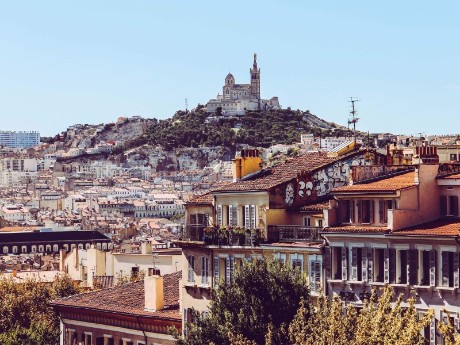
Coastal Marseille has a rich history, once a Phoenician city and today boasting itself as a diverse hub in the south of France. Although Marseille may not have the glitz and glamour of its Provençal neighbours, the city enchants visitors with its authentic charm and vibrant culture. The Old Port is overlooked by the hilltop Notre-Dame de la Garde basilica and is lined with excellent seafood restaurants and lively bars, and a must-see is the quaint Old Town, where you’ll find rows of colourful houses, hilly streets and charming cafes.
Read more
Coastal Marseille has a rich history, once a Phoenician city and today boasting itself as a diverse hub in the south of France. Although Marseille may not have the glitz and glamour of its Provençal neighbours, the city enchants visitors with its authentic charm and vibrant culture. The Old Port is overlooked by the hilltop Notre-Dame de la Garde basilica and is lined with excellent seafood restaurants and lively bars, and a must-see is the quaint Old Town, where you’ll find rows of colourful houses, hilly streets and charming cafes.
Additional Information
Marseille has a complex history. It was founded by the Phoceans (from the Greek city of Phocea) in 600 B.C. and is one of the oldest cities in Europe. The town is a far cry from the Cézanne paintings and Provençal clichés of sleepy villages, "pétanque" players and Marcel Pagnol novels. With around one million inhabitants, Marseille is the second largest city in France in terms of population and the largest in terms of area. Its population is a real melting pot of different cultures. It is also said that there are more Comorian people in Marseille than in Comoros! Indeed, the people of Marseille have varying ethnic backgrounds, with a lot of Italians and Spaniards having immigrated to the area after the Second World War.
For people not afraid to discover a real place with real people, Marseille is the place. From colourful markets (like Noailles market) that will make you feel like you are in Africa, to the Calanques (a natural area of big cliffs falling into the sea - Calanque means fjord), from the Panier area (the oldest place of the town and historically the place where newcomers installed) to the Vieux-Port (old harbor) and the Corniche (a road along the sea) Marseille has definitely a lot to offer.
Forget the Canebière, forget the "savon de Marseille" (Marseille soap), forget the clichés, and just have a ride from l'Estaque to Les Goudes. You will not forget it.
© Sourced from Wikivoyage
Cassis
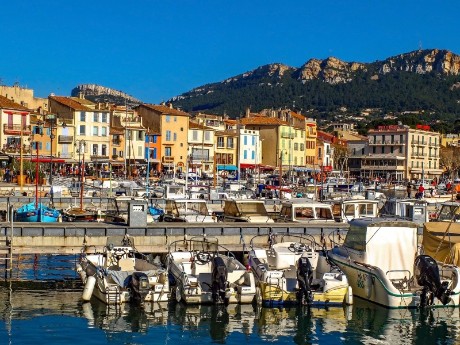
Cassis is a pretty sight; set on France's Côte d'Azur, its pretty port is overlooked by a historic Château and lined with colourful houses, bustling seafood restaurants and fishing boats. Cassis attracts flocks of crowds with its Calanques, secluded coves where white limestone cliffs blend into sparkling turquoise waters, and also boasts itself as one of the region’s top wine producers with surroundings of rolling vineyards. Relax on pristine beaches, sample local specialities and soak up the authentic charm of this scenic village.
Read more
Cassis is a pretty sight; set on France's Côte d'Azur, its pretty port is overlooked by a historic Château and lined with colourful houses, bustling seafood restaurants and fishing boats. Cassis attracts flocks of crowds with its Calanques, secluded coves where white limestone cliffs blend into sparkling turquoise waters, and also boasts itself as one of the region’s top wine producers with surroundings of rolling vineyards. Relax on pristine beaches, sample local specialities and soak up the authentic charm of this scenic village.
Additional Information
"Qu'a vist Paris, se noun a vist Cassis, pou dire: n'ai rèn vist" ("One who has seen Paris and who has not seen Cassis can say: I saw nothing") — these words, spoken by Nobel-prize winning writer Federique Mistral in the local Provençal language, reflect the great attraction that Cassis exerts on all those who go there.
The little fishing port, tucked between two exceptional natural sites (the celebrated Calanques and the majestic Cap Canaille) offers a concentrated version of Provence and the Mediterranean. The magic begins to work on the little road that leads to the village, winding between vineyards and pine trees. Walk along charming back roads lined with the brightly coloured homes of fishermen. Cassis will be forever remembered by those who see its port, boats and welcoming terraces for the first time.
© Sourced from Wikivoyage
Avignon
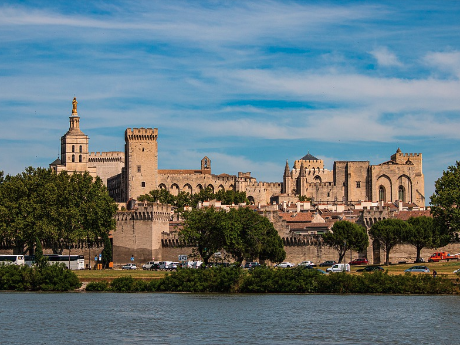
Set on the banks of the Rhône River in southeast France, Avignon is undoubtedly one of Provence’s finest cities. Boasting a number of historic monuments like the sprawling Gothic Palais des Papes and the Romanesque cathedral as well as a collection of elegant cafe-lined squares, world-class museums, local shops and excellent restaurants, this city is not one to be missed. Its annual arts festival and scenic surroundings only add to the charm, and the wide range of accommodation options makes it an excellent choice for overnight stays.
Read more
Set on the banks of the Rhône River in southeast France, Avignon is undoubtedly one of Provence’s finest cities. Boasting a number of historic monuments like the sprawling Gothic Palais des Papes and the Romanesque cathedral as well as a collection of elegant cafe-lined squares, world-class museums, local shops and excellent restaurants, this city is not one to be missed. Its annual arts festival and scenic surroundings only add to the charm, and the wide range of accommodation options makes it an excellent choice for overnight stays.
Additional Information
Avignon is famous as the city to which the Popes fled when leaving the corruption of Rome in the 14th century. Le Palais des Papes (Palace of Popes) which was built then is the world's largest Gothic building. It was largely emptied over the centuries, and its vast stone rooms are filled with little more than old frescos, but it is still an imposing building. The Ramparts themselves were erected to keep the plague and invaders out during the turbulent Middle Ages, when Avignon belonged to the papacy and not the French crown.
Its early history is much older than the popes, however. Avignon occupies a strategic location for several reasons - it is at the confluence of two once-mighty rivers: the Rhône, still one of the biggest rivers in France, and the now largely-dammed Durance. Both were important routes of trade and communication even in prehistoric times. In addition, there is a long island in the Rhone that made it possible to ferry people and goods across, and later bridge the river, more easily than in other places.
It is estimated that about 200,000 people live in Avignon, 16,000 of which live 'intra-muros,' or within the ramparts built in the 14th century.
The city is now sprinkled with buildings and monuments ranging from the new to the old, the very old, and the ageless.
History
Avignon has been continuously inhabited since the stone age, when inhabitations were built in caves in the “Rocher des Doms”, a massive outcropping of rock rising over the banks of the Rhône. Today, a public park with benches, views over the surrounding countryside, a café and playground is on top of the Rocher.
The Romans had a presence in Avignon, though the walls they built lie buried somewhere under the modern streets. Vestiges of the forum can still be seen, lying unassumingly near the Rue Racine and the Rue Saint-Étienne, to the west of the city.
Then, in medieval times, the town grew to an important center of communication and trade. The stone bridge spanning the Rhone was one of only three between the Mediterranean and Lyon. It was undoubtedly for its strategic location and ease of travel that it was chosen by the papacy as home within the then kingdom of Provence. The presence of the papacy made Avignon into a city of great political and economic activity. The old city wall, now visible only as a street that circles the very center of the town (changing names 5 times in the process!) was much too small and a larger wall, still visible today, was necessary to protect its bulging population. Wealthy Cardinals built extravagant palaces known as livrées both within Avignon and across the river, in Villeneuve-lès-Avignon.
The city teemed with activity and building as architects, builders, artists flocked to the town. At that time, within the city walls there were over 100 churches and chapels - many of which have been transformed since then into everything from shops to a movie theater! The wealth and activity generated by the presence of the papacy spilled out into the region, so that even small villages nearby boast a rich architectural past.
© Sourced from Wikivoyage




